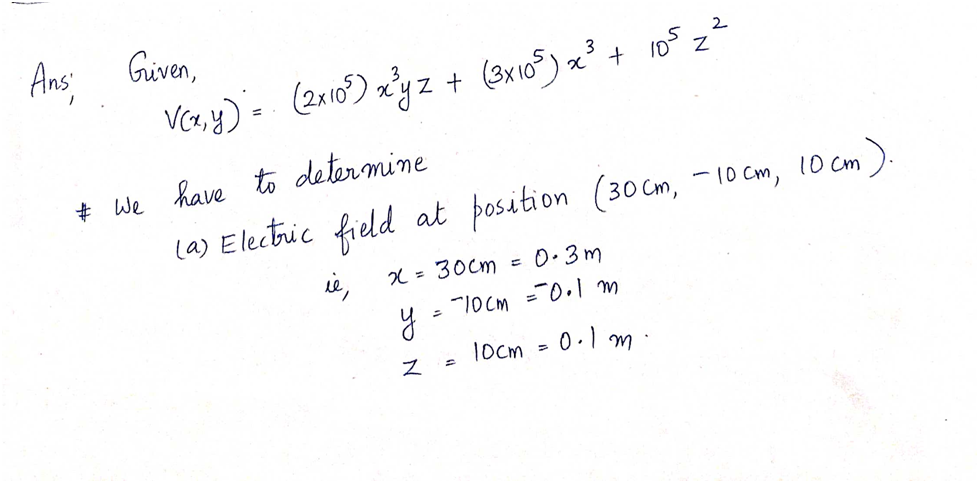(a) The electric potential in a region is given by the equation: V V(x, y) = (2.00 × 105 —5)x³yz + (3.00 × 105 )x³ + (1.00 × 105 ——/2)2² What is the force electric field at position (30cm,-10cm, 10cm)? Give your answer in vector component notation. (b) A point charge of value q = 1.10µC has a speed of ₺ = −3.23 × 10¹ ™ƒ – 1.31 × 104 ™ Ê when it is at the point (0.00 cm, 0.00 cm, 0.00 cm). What is the magnetic field vector in component form at position (30cm,- 10cm, 10cm)? (c) If a region exists with the potential from part (a) and the charge from part (b) what is the net force on a 65.0 mC charge at point (30cm, -10cm, 10cm)moving at speed v = 2.20 × 106 +1.30 × 106? S
(a) The electric potential in a region is given by the equation: V V(x, y) = (2.00 × 105 —5)x³yz + (3.00 × 105 )x³ + (1.00 × 105 ——/2)2² What is the force electric field at position (30cm,-10cm, 10cm)? Give your answer in vector component notation. (b) A point charge of value q = 1.10µC has a speed of ₺ = −3.23 × 10¹ ™ƒ – 1.31 × 104 ™ Ê when it is at the point (0.00 cm, 0.00 cm, 0.00 cm). What is the magnetic field vector in component form at position (30cm,- 10cm, 10cm)? (c) If a region exists with the potential from part (a) and the charge from part (b) what is the net force on a 65.0 mC charge at point (30cm, -10cm, 10cm)moving at speed v = 2.20 × 106 +1.30 × 106? S
Related questions
Question
![### Problem Statement:
(a) **Electric Potential Equation:**
The electric potential in a region is given by the equation:
\[ V(x, y) = (2.00 \times 10^5 \, \frac{V}{m^5}) x^3 yz + (3.00 \times 10^5 \, \frac{V}{m^3}) x^3 + (1.00 \times 10^5 \, \frac{V}{m^2}) z^2 \]
**Question:**
What is the electric field at position \( (30 \text{cm}, -10 \text{cm}, 10 \text{cm}) \)? Provide your answer in vector component notation.
(b) **Magnetic Field Calculation:**
A point charge of value \( q = 1.10 \, \mu C \) has a speed of \( \vec{v} = -3.23 \times 10^4 \, \frac{m}{s} \, \hat{j} - 1.31 \times 10^4 \, \frac{m}{s} \, \hat{k} \) when it is at the point \( (0.00 \, cm, 0.00 \, cm, 0.00 \, cm) \).
**Question:**
What is the magnetic field vector in component form at position \( (30 \text{cm}, -10 \text{cm}, 10 \text{cm}) \)?
(c) **Net Force Calculation:**
If a region exists with the potential from part (a) and the charge from part (b), what is the net force on a \( 65.0 \, mC \) charge at point \( (30 \text{cm}, -10 \text{cm}, 10 \text{cm}) \) moving at speed \( \vec{v} = 2.20 \times 10^6 \, \frac{m}{s} \, \hat{i} + 1.30 \times 10^6 \, \frac{m}{s} \, \hat{j} \) ?
Graphical or diagrammatic elements are not present in this section, so the problem description is purely textual with an emphasis on mathematical expressions and physics principles.](/v2/_next/image?url=https%3A%2F%2Fcontent.bartleby.com%2Fqna-images%2Fquestion%2Fcd9d42bd-58d8-46f6-aafa-68a44e3938d9%2F626d3748-375f-43e4-a998-d4157bc07782%2Fzmjt145_processed.png&w=3840&q=75)
Transcribed Image Text:### Problem Statement:
(a) **Electric Potential Equation:**
The electric potential in a region is given by the equation:
\[ V(x, y) = (2.00 \times 10^5 \, \frac{V}{m^5}) x^3 yz + (3.00 \times 10^5 \, \frac{V}{m^3}) x^3 + (1.00 \times 10^5 \, \frac{V}{m^2}) z^2 \]
**Question:**
What is the electric field at position \( (30 \text{cm}, -10 \text{cm}, 10 \text{cm}) \)? Provide your answer in vector component notation.
(b) **Magnetic Field Calculation:**
A point charge of value \( q = 1.10 \, \mu C \) has a speed of \( \vec{v} = -3.23 \times 10^4 \, \frac{m}{s} \, \hat{j} - 1.31 \times 10^4 \, \frac{m}{s} \, \hat{k} \) when it is at the point \( (0.00 \, cm, 0.00 \, cm, 0.00 \, cm) \).
**Question:**
What is the magnetic field vector in component form at position \( (30 \text{cm}, -10 \text{cm}, 10 \text{cm}) \)?
(c) **Net Force Calculation:**
If a region exists with the potential from part (a) and the charge from part (b), what is the net force on a \( 65.0 \, mC \) charge at point \( (30 \text{cm}, -10 \text{cm}, 10 \text{cm}) \) moving at speed \( \vec{v} = 2.20 \times 10^6 \, \frac{m}{s} \, \hat{i} + 1.30 \times 10^6 \, \frac{m}{s} \, \hat{j} \) ?
Graphical or diagrammatic elements are not present in this section, so the problem description is purely textual with an emphasis on mathematical expressions and physics principles.
Expert Solution
Step 1

Step by step
Solved in 4 steps with 4 images
